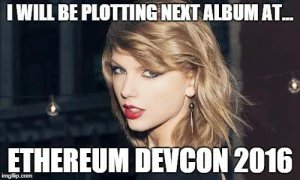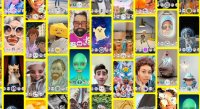
Let’s imagine how it might unfold by 2020 (if not sooner)!
Block–what…?
Today, we do not fully understand what it means to put creative content (music files, photographs, video, et al) on a blockchain (distributed ledger/database of transactions) and create smart contracts to execute business agreement terms (e.g. DRM, payments, payouts).
Within a few years we should have a better sense of how creators and the communities and businesses that support them might adapt to an era of
Distributed Applications (ÐApps) and content marketplaces.
The era of experimentation started October 2015 when Imogen Heap put a song on UjoMusic and Ethereum network. I would not be shocked if a global pop star like Taylor Swift (collaborator with Heap) follows along this path over the next few years.
It’s a bit early say what it really means but we can imagine a simplified experience would be:
1) Digital Assets = ÐApps (Decentralized Applications)
Artist integrate creative work (as digital files) into a (distributed) decentralized application (ÐApps) environment such as Ethereum. Cryptographically secured public and private keys determine who can have access. All transacations (purchases, remixes, et al) are recorded on the blockchain ledger. A majority of financial transactions and DRM issues are managed automatically through contracts.
I’m going to avoid getting into weeds here but artists could choose between more open permissionless blockchain platform (e.g. Bitcoin; Ethereum) or more controlled (likely industry managed or artist cooperative governance) permissioned blockchain (e.g. Eris Industries).
2) Smart Contracts Automate Business side of Digital Assets
In advance of a release, the artist and collaborators (creative or adminstrative) set parameters of use and payment terms for all people and entities. These instructions are programmed it into blockchain-based ‘smart contract’ that executes on terms. All transactions and executed terms are visible and cannot be changed. (e.g. The sound engineer can see all transactions on the ledger and know exactly how much they will receive for each file sold.)
3) ÐApp friendly Content Exchanges Emerge
Where would I buy the file? The consumer layer would likely be one of the existing players (Spotify, Pandora, et al) or new music exchanges (e.g. Ujo Music, 2Gather, Slock.it) designed for the distributed age of digital assets. We can imagine some exchanges will be bare bones and low cost (only receiving payments for computational power) while other exchanges will have fees to support stronger user experience. But the barriers to creating an exchange are low and plug-play with content controlled by artists. The software behind the exchanges are decentrally managed. Resilient. Free from downtime and attacks.
Artist are empower to negotiate terms based on lower cost, higher security, and transparency of blockchain based digital content (that the artist should control). When someone purchases the file or plays it streaming, et al. that triggers the smart contract and automatically disperses money to pre-assigned set of people who contributed to the song. No lag time. No third party fees for processing payment terms. Everyone is paid from consumer to producers without a trusted third party.
Is it that simple?
Not quite. The temptation is to imagine the blockchain giving us: iTunes without iTunes or Spotify without Spotify as it distintermediates the third-party. A more likely scenario is existing players evolve and new exchanges emerge.
We can also imagine new tools and platforms designed to help artists use the ÐApp-friendly exchanges. It will likely be a few years before putting digital assets into a ÐApp friendly world will be as easy as making a website (via WordPress, Wix, et al).
Also, in the end there might be more people involved in the music industry as the digital content becomes a decentralized asset ready for others to grab and push (with permission)! You could write a smart contract that delivers micr0-payments to fans who push out influence across their social webs.
The downsides?!
There will be plenty of new problems and issues to confront. Pricing power could erode or be challenged. You still have to find sweet spot with consumers who expect digital content to be free. (Think Jaron Lanier’s Who Owns the Future)
There might be personal + social power dynamics. Artists might find it difficult to negotiate clear terms with contributors (creative or adminstrative) who also feel empowered. The costs of labor to produce and promote create work could actually rise as everyone feels empowered by hype of this new era.
Publishers and promoters might find lack of incentive in a world with low margins and challenging business terms.
While blockchains are immutable — and you cannot change records of historical transactions. We know that digital content can be copied through a variety of ways. People will continue to find ways to copy sound and image files and place them outside blockchain setting, et al.
Artists might continue to find that livable income levels do not come from selling content but live performances and related materials that drive engagement with their communities.
Back to Taylor Swift please?! When is she transforming music industry?!
How might it unfold? We already have the first signal. A real event.
September 2015
Start with Imogen Heap
In October 2015, UK artist Imogen Heap released a song on the Ujo Music (Twitter) platform.
(Links to articles below)
Ujo Music was developed with Brooklyn-based Consensys (Twitter) and built on top of the Etheruem stack which allows for decentralized management and pre-programmed payment+DRM instructions. (I’ve wrtiten about Ethereum here)
Imogen Heap is full power and her first step was important. But it might not be the headline grabber needed to capture the attention of global audiences and industry leaders.
Taylor Swift joining the ÐApps (Distributed-Decentralized Application) movement of artists and creative contributors has some appeal and plausibility.
What are the (speculative fiction) small events to get us there?
Winter 2016
Taylor Swift hears about Imogen Heap’s leap
Heap and Swift collaborated on a song from Swift’s 1989 album. Swift gained attention in 2015 when she took a public stance against Apple’s initial payment policies on Apple Music. They know each other. Swift has a rabblerouser reputation to uphold
I find it easy to imagine someone in Swift’s orbit will read the story of Heap’s ‘blockchain’ release and do some digging. Then imagine an assistant asking: “Hey Taylor, do you know what a blockchain smart contract is..?”. That could be the start of something unique in arts-content business world.
“HEY TAYLOR, DO YOU KNOW WHAT A BLOCKCHAIN SMART CONTRACT IS..?”
Spring-Summer 2016
Taylor Swift stops by Brooklyn headquarters of Consensys
Swift has a NYC home and is only a few miles from Brooklyn-based Ethereum ÐApp developer Consensys who is behind the Ujo Music platform. Imagine one day in the Winter of 2016 Swift traveling to Brooklyn for a undercover crash course on cryptographically secured digital assets. (Or Swfit sends a team to Ethereum DevCon 2016!)
Fall 2016
The Intention Goes Public
Swift announces that her next album will be simulataneously released on the Ethereum blockchain… Half the price of purchasing the album through traditional channels.
Fans scramble to figure out how to get Ether (currency of Ethereum network)…
The media is confused and but goes after the story. Music company stocks drop and the real hype begins.
Buzz builds as other artists follow the meme… but still nobody can describe the blockchain!
December 2021
Settle back to Reality
The dust settles. Some things have changed for better. Some for the worse. Some things have not changed. Platforms like Ethereum mature and developers deliver on consumer-friendly experiences. Artists from music to photography to film now feel emboldened and empowered to rethinking the business side of the creative work.
A range of DApps friendly exchanges emerge. Some based on geography (LA has a music exchange for LA artists). Some based on genre (Hip Hop artists benefited by a branded Hip Hop exchange.
Bloggers and artists start to pick apart this new era and complain that it’s still hard to make a living as an artist.
Time Magazine™ names Taylor Swift Person of Year for moving artists into a new era of control of their content.
It could happen.. !








